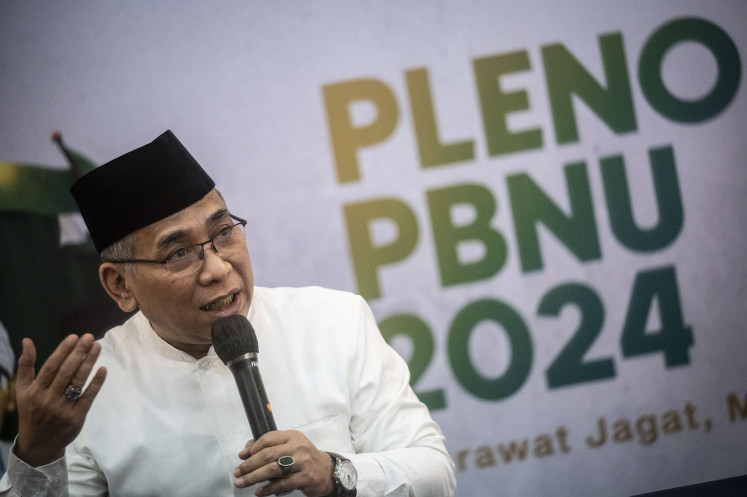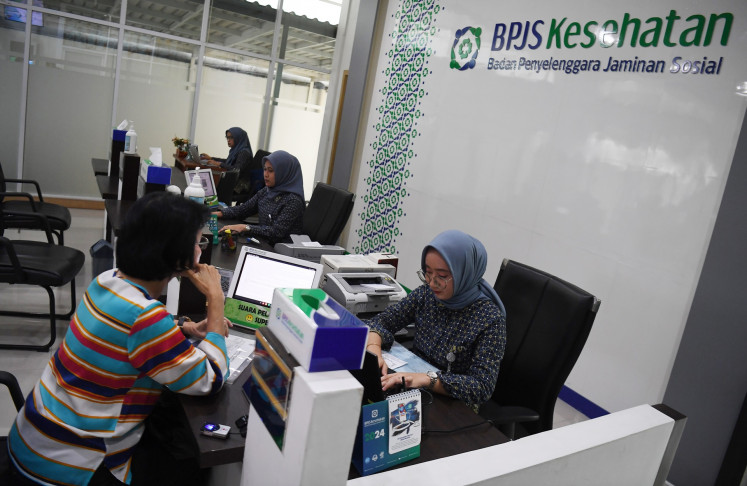Popular Reads
Top Results
Can't find what you're looking for?
View all search resultsPopular Reads
Top Results
Can't find what you're looking for?
View all search resultsOnrust Island struggles for survival, recognition
So new yet so fragile: Parts of Onrust’s new dike the administration built in 2002 and 2003, are already cracked and damaged
Change text size
Gift Premium Articles
to Anyone
So new yet so fragile: Parts of Onrust’s new dike the administration built in 2002 and 2003, are already cracked and damaged. (JP/Agnes Winarti)
Despite the city administration declaring Onrust Island a protected historical site almost four decades ago, the majority of the island’s visitors are fishermen, rather than people interested in the site’s history.
“I have been fishing here since 1991. My father used to bring me here,” said Barouk, a resident of Tanah Abang, Central Jakarta, who was camping near the remains of a Dutch fort in Kelor Island. The less than one-hectare island is about one kilometer away from Onrust.
Onrust, once a bustling Dutch shipyard and port, is located in the Thousand Islands.
‘The water is calm here,” he said. “I could catch up to four kilograms of squids and fish every day.”
In 1972, Jakarta governor Ali Sadikin declared Onrust a protected historical site. In 2002, the administration made Onrust and its three neighboring islands - Bidadari, Kelor and Cipir – an archaeological park, because of the artifacts and ruins that were discovered there.
During the 17th and 18th centuries, Onrust - believed to be one of the largest shipyards in Southeast Asia - and its three neighboring islands, were key strategic posts the Dutch East India Company (VOC) used to defend Batavia, now Jakarta.
While a section of Bidadari Island is now a resort catering for up to 50 visitors a day, Onrust, Kelor and Cipir islands have remained under the tourists’ radar.
“Many of our visitors come to fish rather than visit historical sites,” Mahdi Effendi, head of the city tourism and culture agency’s Onrust Archaeology Park division told The Jakarta Post recently.
Last year, Onrust welcomed 15,000 visitors.
“The figures were much better than last year’s, when we only recorded 8,000 visitors,” said Mahdi.
Fishermen and the sea: Two men stand on a wave breaker near Onrust island, in the Thousand Islands, fishing baronang (Siganus lineatus). Most visitors to Onrust, once a Dutch port, are fishermen rather than visitors touring historical sites. (JP/Agnes Winarti)
Most of the fishermen visiting the islands only pay half of the entrance ticket price, or Rp 2,000. Some end up not paying anything as there are no officers attending the entrance of Onrust’s archeological park.
“We do not have any boats available to ferry visitors between our islands and Jakarta, let alone officers to monitor visitors entering the park,” said site officer Purwo Lesono.
The administration used to provide a boat that could carry up to 16 people, but this service came to an end after the boat was badly damaged.
As a result, renting a fisherman’s boat at North Jakarta’s Muara Kamal fish auction market has become the most affordable option for both employees and visitors going to the island. Visitors can also rent a more expensive boat from Marina dock in Ancol and Muara Angke fish market.
It takes 20 minutes to travel the 14 kilometers distance between Muara Kamal and Onrust, while Onrust is only one to two kilometers away from the other islands.
“A regular shuttle service to Onrust and its neighboring islands is urgently required. It is the most basic thing we must provide visitors,” said Purwo.
This year, Onrust is hoping to attract 20,000 visitors.
Bad weather also prevents visitors from accessing the islands.
“During the rainy season, Jakarta waters are quite rough and daunting for people sailing to the islands,” Mahdi said.
Onrust’s size has shrunk as a result of erosion, from its original 12 hectares to 7.5 hectares in 2002. In that year, the administration built a dike around the island, made out of concrete. About 30 percent of the dike is now damaged.
Last fort: A visitor takes a picture of the ruins of an old Dutch fort in Kelor Island, located two kilometers away from Onrust. The fort was once used as a surveillance post to store gunpowder. (JP/Agnes Winarti)
The Dutch had to rebuild their Onrust Island naval bases several times, after repeated attacks by the British fleets. In 1883, a tidal wave - caused by the eruption of the Krakatoa Volcano in the Sunda Strait - destroyed the last Dutch navy base in the island. When the construction of Tanjung Priok port began, Onrust was deserted.
During the 19th century, Onrust was used as a sanatorium for people suffering from tuberculosis. Afterwards, the island was used by haj pilgrims heading to and returning from Mecca. The barracks, which could hold up to 3,500 pilgrims, used to occupy two-thirds of the island.
Before Governor Ali Sadikin declared Onrust a protected historical site, there were many thefts, from artifacts to old building ruins, including roofs, bricks and woods. As of today, only a handful of ruins remain.
Mary’s tomb: A visitor takes a picture of the tombstone belonging to Maria Van Veldeslyk, who died in 1693. Maria Van Veldeslyk and Anna Adriana Duran’s tombstones are the only Dutch tombs left intact in Onrust. The rest have been damaged throughout the years. (JP/Agnes Winarti)
Sights of interest in Onrust include an unattended graveyard, a run-down prison building that has been newly renovated, a new hospital serving as a museum showcasing pictures, artifacts and a miniature reproduction of what the island used to look like.
Remains of the Dutch dike can also been seen along the shores of Onrust. There are similar remains in Bidadari Island and a dilapidated Martello tower as well as a crumbling fort in Kelor Island.
“I have read the history of Onrust Island. I’ve seen the pictures in books. They are beautiful. I would have never guessed its historical site had been so neglected,” said Ken Paramita, a 19-year-old history student at the University of Indonesia, while she noticed the damaged tombs in the island’s graveyard.
“Wild plants and trash should be regularly removed from the sites,” said Ken.
Mahdi said that the amount of garbage coming from Jakarta’s mainland was a problem too. Some fishermen added that when annual floods hit Jakarta, disused sofas, cupboards and beds wash up on the islands’ shores.
Rangga, an archaeology student visiting Onrust, said better services should be provided to visitors, such as tour guides and comprehensive literature on the island’s history.
“In that way, visitors can get a better idea of what living on this island was like many years ago,” said Rangga.
Site officer Purwo said his office is still looking into how to showcase the island’s history, given the small amount of historical buildings left.
“We are currently focusing on how to better attract visitors to Onrust. Hopefully, we will come up with a solution at the end of this year,” Purwo said.
This year, the administration allocated Rp 1 billion to the Onrust Archaeology Park, of which Rp 500 million went toward marketing, Rp 300 million toward maintenance, Rp 36 million toward renovations and the rest toward other operational expenses.
Cost and transportation alternatives to Onrust Island:
1. Most affordable: rent a fisherman’s boat in Muara Kamal fish auction, North Jakarta. The boat does a round trip from Muara - stopping in Kamal, Onrust, Kelor, Cipir and Bidadari - and costs Rp 300,000 to Rp 400,000. The boat can take up to 30 passengers. Onrust is 15 to 20 minutes from Muara Kamal. To get to Muara Kamal: Take the Harmoni-Kalideres busway to Rawa Buaya. Jump on an ojek to Muara Kamal auction fish (Rp 10,000) or catch a red minibus in Kota. Look for the D06 going from Kota to Kamal and Kapuk and get off at Muara Kamal auction fish.
2. Rent a boat from the Muara Angke fish market. A round trip will cost Rp 6 million and can take up to 60 passengers. Onrust is about 20 minutes from Muara Angke.
3. Rent a ferry boat from Ancol Marina. A four-hour round trip will cost Rp 15 million and can take up to 70 passengers. Onrust is about 45 minutes from Ancol Marina.
4. Catch a boat from Bidadari. The Bidadari round trip - which stops in Onrust, Cipir, and Kelor - takes 2 hours and costs Rp 250,000 per passenger, with a minimum of five passengers and a maximum of 30. Entrance ticket to Bidadari cost Rp 25,000.













